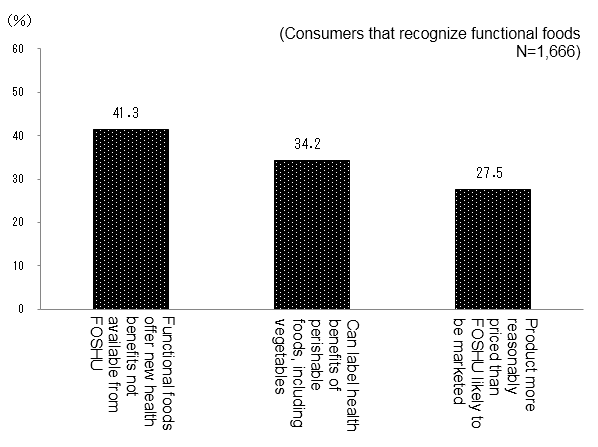- Suntory Beverage & Food
- > News Release
- > Suntory FOSHU Beverage Report
News Release
- No.SBF0360(2015/10/1)
-


Suntory FOSHU Beverage Report
FOSHU beverages are now everyday drinks not just taken with meals
More than one-third of FOSHU beverage consumers drink FOSHU beverages more than once a week. Selected for being both “healthy and beneficial”
and for their “great taste and drinkability”
In 2015, Suntory Beverage & Food Limited (SBF) implemented a consumer trends survey on canned or bottled non-alcoholic drinks classified as "Foods for Specified Health Use" (FOSHU beverages). The first survey was carried out in 2014. This report shows a comparison with results from the 2014 survey and introduces recent trends in the FOSHU beverage market.
I. FOSHU beverage market
II. Summary of the 2015 consumer trend survey on FOSHU beverages
III. Detailed results of the 2015 consumer trend survey on FOSHU beverages
(1) Consumption ratio over the past year and weekly consumption frequency
(2) Reasons for drinking FOSHU beverages and situations where they are consumed
(3) Consumer focus at the time of purchase
(4) Change in awareness of FOSHU beverages
<Reference> Regarding functional foods
I. FOSHU beverage market
Foods for specified health use (FOSHU foods/beverages) are designated and labeled based on authorization in accordance with Article 26 Paragraph 1 of Japan’s Health Promotion Act* or approval in accordance with Article 29 Paragraph 1 of the same law. The designation indicates to those consuming the food or beverage as part of their diet that they can expect to enjoy the specific health maintenance claim on the labeling.
* The Health Promotion Act was enacted and promulgated in 2002, to address the needs of an aging population and changes in population disease structure. Its purpose is to promote the health of the people in Japan and prevent disease.
FOSHU foods and beverages are labeled to express potential health claims consumers can expect from consuming these products. However, these products must first undergo government screening and then be approved by the director general of the Consumer Affairs Agency (CAA).
In recent years, many new FOSHU beverages have been developed for commercial marketing. FOSHU beverage sales plateaued at one point but the market picked back up around 2012. Consequently, the main FOSHU beverage market (excluding beverages with health claims for intestinal regulation) grew to around 120.0 billion yen. In 2015, the market is expected to continue to grow.
Market for Main FOSHU Beverages (excluding those with intestinal health claims)
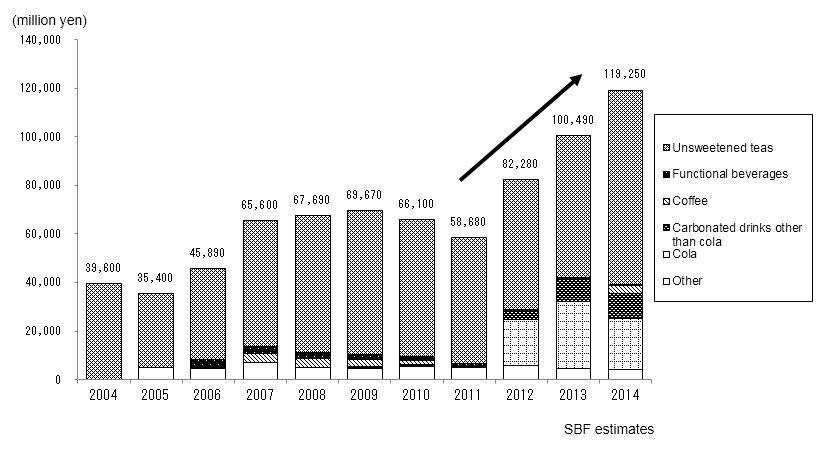
II. Summary of the 2015 consumer trend survey on FOSHU beverages
■Trends indicate that consumers are aware that switching to FOSHU beverages, from what they regularly drink, can easily lead to better health habits. In addition, FOSHU beverages appear to be being consumed in a wider range of situations as a regular, everyday beverage.
■In addition to good health and potential benefits, consumers are also placing equal emphasis on great taste and drinkability. Based on our survey, beneficial qualities and great taste are both key points for purchase.
■More than 60% of consumers that drank FOSHU beverages over the past year responded:
・There is a wider selection than before
・Can now be consumed anytime
In addition, nearly 50% of respondents said FOSHU beverages taste better than before.
Given the change in consumer attitudes, we believe FOSHU beverages are now consumed as regular, everyday beverages, as there is a wider selection making for easier choices, which is leading to more situations where FOSHU beverages are consumed. We also estimate the consumption of FOSHU beverages has increased and that these factors are contributing to an expansion in the market.
III. Detailed results of the 2015 consumer trend survey on FOSHU beverages
Survey overview
・Survey target
Men and women aged 20 to 79 living in Japan
・Survey size
Screening survey: 21,178 people (10,445 men and 10,733 women)
Main survey: 1,800 consumers (900 men and 900 women) that consumed beverages for specified health uses (FOSHU) over the past year
・Survey method
Internet survey
・Survey period
August 7, 2015 (Friday) to August 10, 2015 (Monday)
(1) Consumption ratio over the past year and weekly consumption frequency
| The consumption rate for FOSHU beverages topped 40% for the second consecutive year. More than one-third of FOSHU beverage consumers drink FOSHU beverages more than once a week |
Of the total number of respondents, 43.8% said they had consumed a FOSHU beverage over the past year (Figure 1). This was slightly lower than a year earlier. However, this possibly reflects the fact that our 2014 survey (April 2014) coincided with a series of new FOSHU beverage product releases. Nonetheless, consumption frequency over the past year remained at a high level—more than 40% of those surveyed.
Meanwhile, 34.2% of respondents that said they had consumed a FOSHU beverage over the past year drank FOSHU beverages more than once a week. This was an improvement of 3.2 points in comparison with the previous survey (31.0%) (Figure 2). The average per-person consumption frequency rose from 1.6 times per week to 2.0 times per week. Based on these results, we estimate that the increase in consumption frequency among FOSHU beverage drinkers is contributing to an expansion of the FOSHU beverage market.
Figure 1. Consumption Rate for FOSHU Beverages over the Past Year
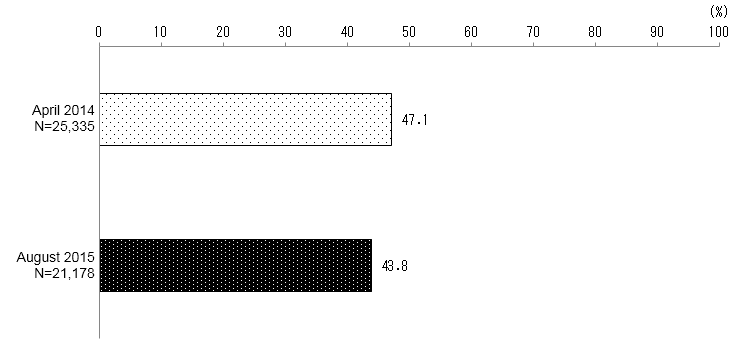
Figure 2. Weekly Consumption Frequency of FOSHU Beverages
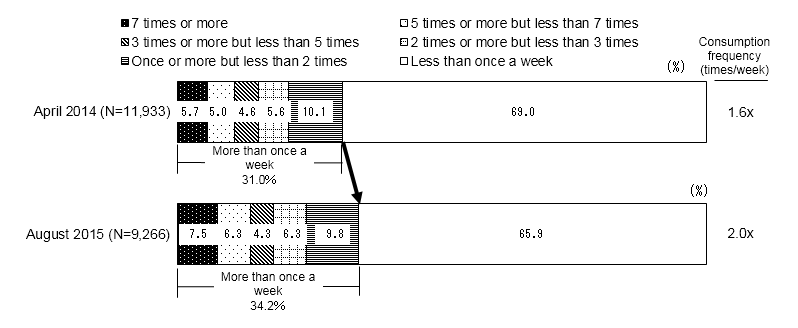
(2) Reasons for drinking FOSHU beverages and situations where they are consumed
| About 40% responded that they “might as well drink something healthy.” This was the top reason. “While relaxing at home” ranked third among situations where FOSHU beverages are consumed. Increase in other situations including “while working or studying” and “work or study breaks” |
We asked respondents that said they had consumed FOSHU beverages over the past year what the top reason was for drinking FOSHU beverages. Nearly 40% of these respondents said that they felt they “might as well drink something healthy” (Figure 3). Many people also drank FOSHU beverages regularly for rehydration (18.3%). These trends indicate that consumers are aware that switching to FOSHU beverages, from what they regularly drink, can easily lead to better health habits. Many respondents also gave the following answers: “drank after eating greasy foods (27.8%)” and “do not want to gain weight (25.8%)”.
In addition, respondents that said they had consumed FOSHU beverages over the past year were asked when they regularly consumed FOSHU beverages (Figure 4). In the previous survey, the top three answers were “during dinner,” “during lunch,” and “after a meal.” The top two answers remained the same but the response that ranked third was “while relaxing at home.” Another characteristic was that scores rose for “while working or studying” (8.7%→10.5%) and “work or study breaks” (7.6%→9.4%). Consumers are not only making it a point to drink FOSHU beverages with meals but are expanding the situations where they drink FOSHU beverages on a regular basis.
Figure 3 Reasons for Drinking FOSHU Beverages (top 12)
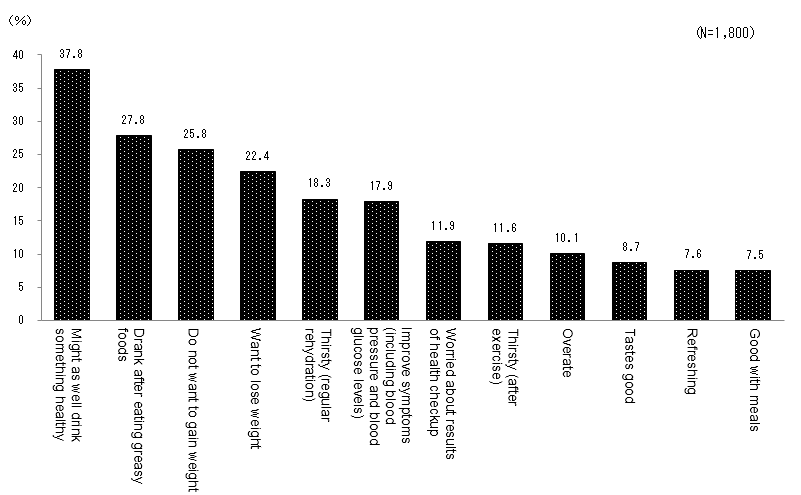
Figure 4. Situations Where FOSHU Beverages were Consumed (top 12)
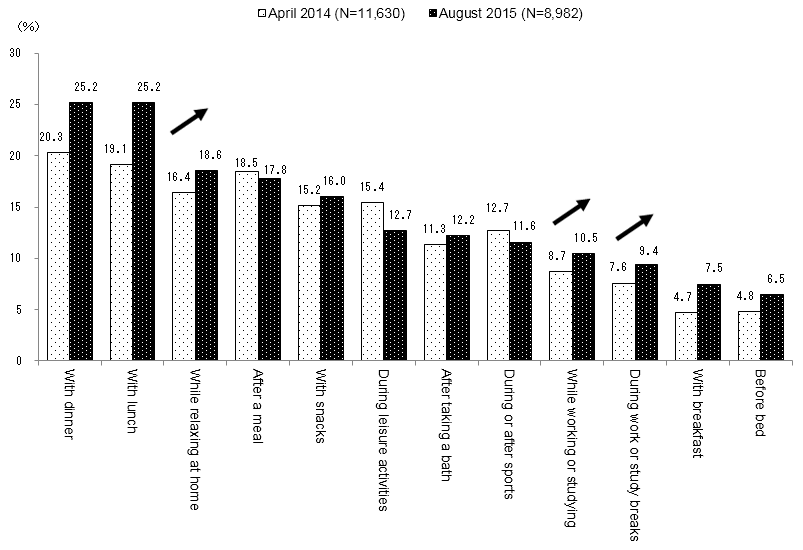
(3) Consumer focus at the time of purchase
| In addition to good health and potential benefits, consumers are also placing equal emphasis on great taste and drinkability. |
We also asked respondents that said they had consumed FOSHU beverages over the past year what the key points of focus were when purchasing a FOSHU beverage (Figure 5). In order of emphasis, respondents answered “seems good for your health” and “potential benefits.” At the same time, taste and drinkability were also key points of focus. Based on our survey, both of these are the top key determinants in the purchase decision process. Other key points of focus when purchasing a FOSHU beverage were “trustworthy brand” and “good quality.”
Consumers appear to remain budget-minded. In the case of FOSHU beverages, owing to a heightened awareness of health issues, consumers are seeking products that are affordable and taste great and which they expect to be beneficial to their health.
Figure 5. Key Determinants Motivating the Purchase of FOSHU Beverages (top 12)
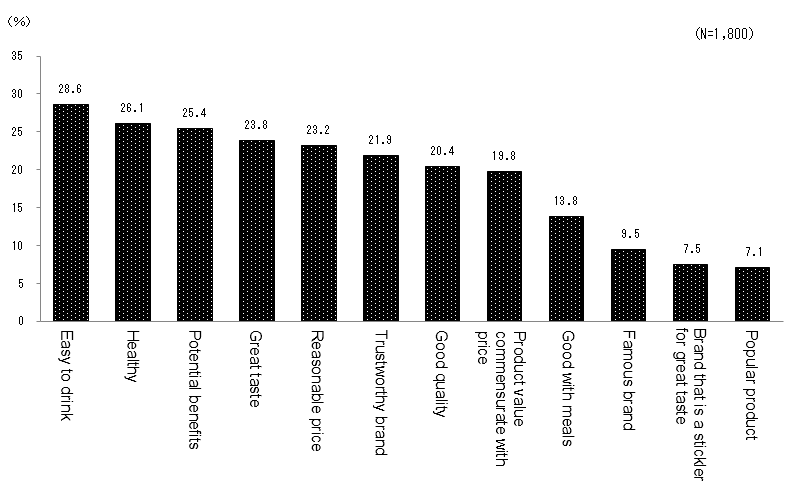
(4) Change in awareness of FOSHU beverages
| More than 60% of respondents said there was a “wider selection than before” and “can now be consumed anytime”. Nearly 50% of respondents said that FOSHU beverages taste better than before. |
Respondents that said they had consumed FOSHU beverages over the past year were also asked whether their attitude towards FOSHU beverages has changed in the past 12 months. Of those that responded “yes” (Top 3 Box total for “very much so,” “yes,” and “somewhat”) 68.5% said they felt there was a “wider selection than before,” 60.8% said they believed FOSHU beverages “can now be consumed anytime” (Figure 6). Meanwhile, 46.6% said that they believed that FOSHU beverages were “better tasting than before.”
Figure 6. Change in Consumer Attitudes towards FOSHU Beverages
(Top 7 items for which consumers answered “very much so,” “yes,” and “somewhat”: Top 3 Box total)
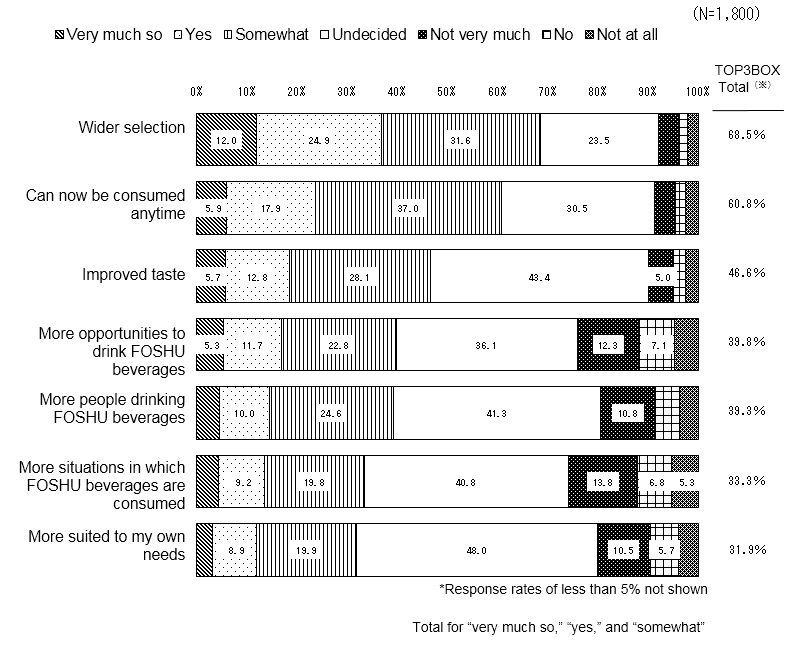
Given this change in consumer attitudes toward FOSHU beverages, we believe that FOSHU beverages are now consumed as regular, everyday beverages, as there is a wider selection making for easier choices, which is leading to more situations where FOSHU beverages are consumed. We also estimate the consumption of FOSHU beverages has increased and that these factors are contributing to an expansion in the market.
<Reference>
Regarding functional foods
| Directions for the labeling system on food functions and nutrients have been in effect for six months; new benefits can be expected going forward |
Nearly six months have passed since the directions for the labeling system on food functions and nutrients was put into effect in April 2015. Manufacturers and other companies are responsible for filing with the CAA for foods labeled to express specific functions. These functions must be backed by scientific evidence. The labeling system has widened the range of products that can potentially be marketed given that it allows for the labeling of functions that are not recognized under the FOSHU system guidelines. Accordingly, manufacturers have begun launching various functional food products since June 2015.
Twenty four years have passed since the start of the FOSHU system in 1991. More than 90% of consumers are aware of FOSHU. Six months have passed since the start of the labeling system. We conducted a survey to assess the recognition rate and level of expectation consumers have in functional foods.
(1) Recognition of functional foods
| Recognition rate of more than 80% |
We surveyed all the subjects of the screening survey to assess the recognition rate of functional foods (Figure 7).
The recognition rate for FOSHU was over 90% (Top 3 Box total for “clear idea of their content and characteristics,” “some idea of their content and characteristics,” and “heard the term before”). The recognition rate was over 50% for those with an idea of their content and characteristics (Top 2 Box total for “clear idea of their content and characteristics” and “ some idea of their content and characteristics”).
The recognition rate for functional foods exceeds 80%. This includes people that recognize functional foods despite the fact that the labeling system has only been in place for less than six months. This indicates the interest consumers have in functional foods. Of the total number of consumers surveyed, one-third had an idea of the content and characteristics of functional foods.
Figure 7. Recognition Rate for FOSHU and Functional Foods
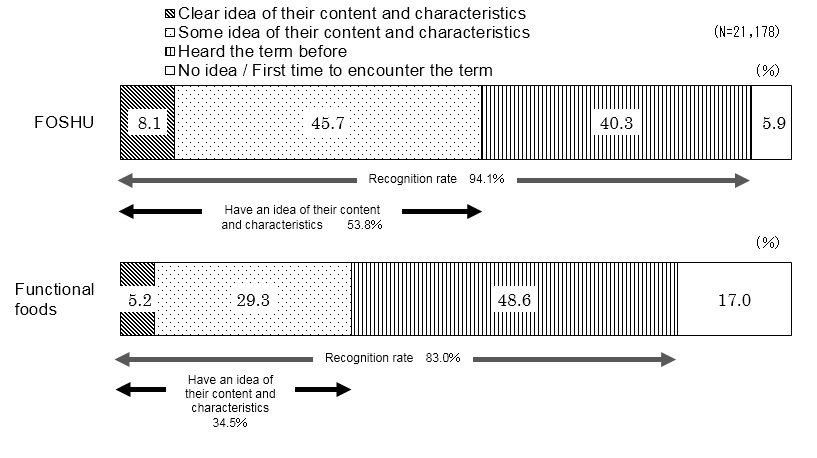
(2) Consumer expectations of functional foods (versus FOSHU)
| High expectations for the introduction of products that promote new benefits. |
We asked those consumers who responded they had an understanding of functional foods (“clear idea of their content and characteristics,” “ some idea of their content and characteristics,” and “ heard the term before”) if they recognized the difference between FOSHU and functional foods. Most (41.3%) answered that they believed “functional foods offer new health benefits not available from FOSHU” (Figure 8). The results indicate that many consumers are looking forward to the release of new functional foods.
Figure 8. Recognition Rate of FOSHU and Functional Foods
